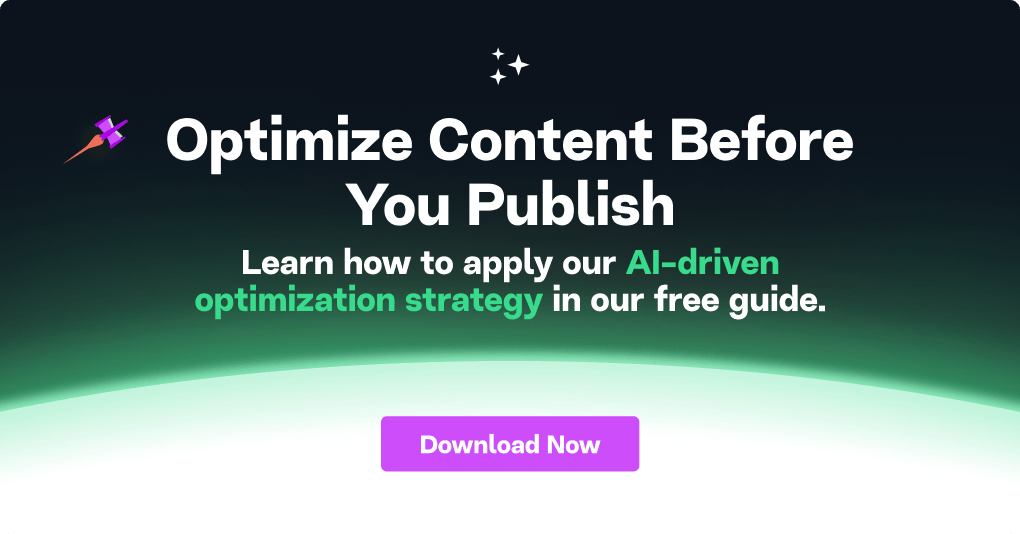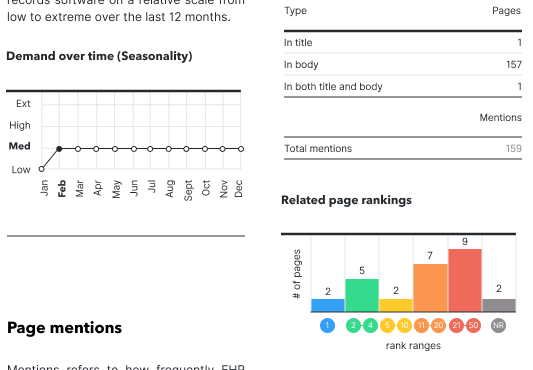SERP Analysis Starts Where Keyword Research Ends
According to John Mueller, Webmaster Trends Analyst at Google, the most important ranking factor is “awesomeness.” That’s sound advice, despite it being difficult to implement. How do you use that guidance to win out over your rivals?
The competition is not slowing down for highly sought-after search terms. It’s an intense battle in which any slight advantage can make a substantial difference.
In this post we look at traditional competitive SERP analysis, why it’s no longer enough, and then propose an alternative.

The Traditional Approach to SERP Tracking
SERP analysis tools are typically built upon some sort of rank checker. So, they provide things like keyword volume, difficulty (link metrics), potential (click-through rates), domain authority, ranking, and some SERP features for good measure.
But there’s a problem with this scenario. It does provide the right insight. You’re still left wondering why the competition is ranking and how they can be overcome.
SERP analysis, in this situation, is really an extension of keyword research.
The Importance of This Approach to SERP Analysis
Keyword research isn’t always good enough, especially when dealing with high-competitive keywords. In this situation, you need an in-depth SERP analysis to unearth the nuances of how a topic is translated within Google’s search engine. Not only that, it’s imperative you understand how the competitive landscape is constructed around that topic.
To turn these insights into action, you’ll find a thorough analysis of your content against that topic to be constructive. Most content strategists find they get greater value out of improving existing content as opposed to something new. For important search terms, you should have a list of targeted and competitively driven opportunities for optimization.
How This Type of Competitive Analysis Fosters Search Success
Conducting a topical analysis of the SERP landscape helps organizations succeed in numerous ways.
1. A better understanding of the current performance of your domain concerning that topic. To rank well for highly competitive search terms, you can’t just think about how well the one page does for a search term. While any rank tracking tool can do that, it’s not good enough.
You need to understand how your domain as a whole performs for that topic. You most likely have many pages, each addressing a different search intent, for that topic. That’s how you build domain authority! Unfortunately, your typical rank tracker does not provide insight into which pages surrounding a specific topic need improvement – their approach lacks a topical perspective.
2. Improved comprehension of the competitive landscape. The goal of a search engine is to match every search query with the most relevant content. Your blog post doesn’t stand in isolation. Rather, it is going to be evaluated by search engines in the context of the competition. Therefore, it’s imperative you have some keen awareness of your SERP competitors.
3. Gap analysis is part of that awareness. But let’s be realistic. This type of analysis, at both the content and site level, is far too time-consuming to perform manually. It needs to be automated; otherwise, the SERP environment may have changed before you’ve even concluded the analysis!
4. Content breadth, depth, authority, and demand are a few relevant key performance indicators that you will want to investigate. Let’s not forget to include basic SEO evaluation metrics such as word count, internal/external linking and content score for measuring content quality. In this context, search engine optimization is really on-page optimization.
What’s Involved in Creating an In-depth Competitor Analysis
For this type of analysis, we need to create a topical construction within the SERP. Doing this requires some robust topic modeling, something that a SERP analysis tool can’t do. We must examine our content against a comparative model of the competition.
Why?
Although there are many ranking factors, content still reigns as king in 2019. If your content can’t compete on quality, everything else is moot. What we require is a deep dive into the competitive landscape to understand how our content compares to the top-ranking pages.
Ranking Metrics That Offer Important Insight
When analyzing the content of SERP competitors, some essential data can help us with our task. Here are a few:
Pages mentioning the topic (keyword) and whether it’s mentioned in the title, in the body or both.
Related page rankings – how well pages for topics related to the focus topic actually rank.

A list of related topics. Ideally, this is ordered by relevance making it easier to optimize existing content.
A list of important intent-focused topic variants. Helpful when writing content, these variants should be highly related to the focus topic and frequently found in the SERP. Clustering them by primary intent (informational, commercial, transactional) makes it even more valuable.
SERP features including rich snippets, and the presence of any related questions and ads. This helps to understand the search results better and analyze user intent.
Content scores and word counts for the top SERP competitors – provides insight into the quality of their content and writing.
A heatmap showing how the top-ranking pages cover this topic – so you can exploit any content gaps they may have. Better yet, show me the must-have topics, topic gaps, and important topics so you can quickly determine your plan of attack.

Competitor analysis of each top-ranking page showing other terms for which they rank, a breakdown of their internal and external links, plus their usage of related topics. That lets you dig deep into how the competition constructs their content.
SERP Analysis Use Cases
How can we use all this information to gain a competitive advantage in organic search? Let’s take a look at some specific examples of what these metrics can reveal.
- How well is a company performing on a given topic (ranking and content scores)?
- What is the content quality of a piece (content score) now and how it can be optimized (gap analysis)?
- What is an organization’s total inventory of pages surrounding a topic? How is each page performing to cover a topic comprehensively?
- On which high-level sub-topics should a company focus, based on authority, demand, and gap?
- Which pages are of most importance for a topic? Which pages provide little value? What pages need to be created? That’s based on the inventory surrounding a topic site, the topical makeup of those pages in comparison to competitors, the current performance of each of these pages and the pages that carry the must-have subtopics.
- What is the favored intent? (based on the SERP features populated)
- How is the competition building their content? What does Google deem as an important page type to match intent.
- What are the critical subtopics on which the top-ranking pages focus? What are the gaps in their content that I can exploit?
- What do these top-ranking pages look like? That can provide insight into template construction.
- How well do my organization and the competition convey information? A combination of content score and word count indicates the quality of writing. High word count plus low content score – the writer has trouble getting to the point, and the article is probably filled with irrelevant content.
- Which pages are competitors internally linking to for a given topic? This information can provide organizations with a solid foundation for understanding what Google finds valuable. It is a ranking factor in that Google will validate pages based on their internal link structure. Are you sending the Google user to the most important and relevant pages in their journey on your site?
- Which pages are competitors externally linking to for a given topic? Similar to internal linking, it’s a ranking factor in that Google will validate pages based on their external link structure. Are you sending the Google user to the most important and relevant pages in their journey from your site to external domains?
Takeaway
Although this type of topical SERP analysis can be the difference between ranking or not, you’ll most likely want to reserve it for your most competitive search terms. It’s these situations that you’ll want to tackle most aggressively.
On the other hand, an analysis like this can also reveal that the time is not right to address such a competitive search term. At least you’ll have a clear understanding of why you should revise your strategy.
What you should do now
When you’re ready… here are 3 ways we can help you publish better content, faster:
- Book time with MarketMuse Schedule a live demo with one of our strategists to see how MarketMuse can help your team reach their content goals.
- If you’d like to learn how to create better content faster, visit our blog. It’s full of resources to help scale content.
- If you know another marketer who’d enjoy reading this page, share it with them via email, LinkedIn, Twitter, or Facebook.
Stephen leads the content strategy blog for MarketMuse, an AI-powered Content Intelligence and Strategy Platform. You can connect with him on social or his personal blog.